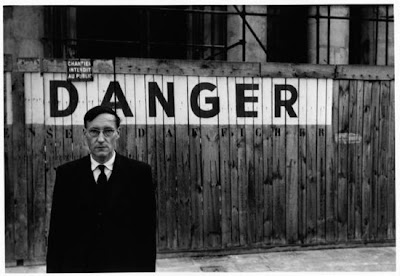 |
| William Burroughs photographed by Brion Gysin, Paris 1959. |
This past year has seen a revitalised interest in William Burroughs as a visual artist. The standard reference work when it comes to that aspect is of course the catalogue for his 1996 Los Angeles exhibition: Ports of Entry. It contains a massive dose of his shotgun paintings and at that time fairly recent work. Well worth having.
Late 2012 saw an exhibition called Cut-Ups, Cut-Ins, Cut-Outs: The Art of William
Burroughs, at Kunsthalle Wien in Austria. I didn’t get to see that
unfortunately, but I did get the catalogue recently. I won’t only recommend it
but will also say it’s pretty essential if you’re into Burroughsiana.
Although fairly small in scale, this book
focuses on an important phase and aspect of the budding cut-up impressario: the
visual workflow. Reproduced here are many early sheets, spreads and collages
that are indeed text-based experiments but just as much visual artworks.
Burroughs worked so closely together with Brion Gysin at this time (very late
50s/early 60s) that an influence was surely inevitable.
However, this goes beyond the mere shuffling
of cut up sheets of typewritten text. Burroughs seemed to have integrated a
totally palimpsestic view of life (a cause or effect in his chemically enhanced
lifestyle?), working just as much with photographs, images, colouring and
re-assembling finished assemblages.
His creative existence no longer merely
consisted of writing about impressions from the outside world (as in the first
narrative attempts And the Hippos Were
Boiled in Their Tanks and Junky) but
rather of a zone in which initial impressions were dry tumbled and regurgitated
endlessly. Out of this turbulent yet highly creative process, lines of poetic
and prophetic grandeur emerged and became the basis of much of his early,
groundbreaking work: Minutes To Go, Nova Express, and Exterminator, for instance.
”By this time you will have gained some
insight into the Control Machine and how it operates. You will hear the
disembodied voice which speaks through any newspaper on lines of association
and juxtaposition. The mechanism has no voice of its own and can talk
indirectly only through the words of others… speaking through comic strips…
news items… advertisements… talking, above all, through names and numbers. Numbers
are repetition and repetition is what produces events.” (Burroughs in The Third Mind, 1978)
This catalogue contains reproductions of some
(actually, a minute fraction of thousands of pages/artworks) striking images in
which the border between text and artwork is truly rubbed out. There is also a
section of later work from the 1980s: shotgun paintings, objects and drawings.
These seem included more or less for the hell of it. On the whole, they are vastly
inferior and basically only bear witness to a mind that didn’t cease to
experiment but who, towards the end, couldn’t (or perhaps didn’t want to)
integrate source material of symbolic or potent value (like the earlier
newspaper clippings and literary sources). Burroughs seemed content with being
in the midst of random processes en soi,
with raw source material like plywood and used doors.
There are also some very interesting texts in
this book. Barry Miles, who is both biographer (El Hombre Invisible, 1994, and now working on a 2014 centennial
biography) and an early WSB archivist, both writes and is interviewed about
Burroughs’s obsessive working methods when it came to the cut-ups. One
shouldn’t forget that Burroughs tried to branch out into many fields of
artistic expression, and there are interesting stories here about the early
cut-up experiments with sound, for instance. It was a seminal phase indeed, and
Burroughs’ initial experiments in various media together with Brion Gysin
(mainly) left explosive seeds of inspiration for many generations to come.
Aside from the Miles input, there is also an
initiated analysis by Jon Savage of Burroughs as an at times almost unwilling pop
icon, and an interview with Burroughs by Sonic Youth’s Lee Ranaldo, mainly
about his various Moroccan phases and the influence of Tangier on work and
lifestyle.
In all, a book definitely worth getting. It
may not be totally essential, but it’s certainly revealing when looking at that
first phase of experimentation which became defining not only for Burroughs
himself as an author (and, yes, as an artist) but also for thousands of
would-be and de-facto experimentalists eager to rub out their own words and
find their own third minds somewhere between the bulging bookshelf and
”Interzone” proper.
Cut-Ups,
Cut-Ins, Cut-Outs: The Art of William Burroughs
Kunsthalle Wien/Verlag für Moderne Kunst,
Nürnberg, 2012
Please note that the publishers Walter König
are releasing another book focusing on Burroughs’ art (as well as writings): Cut, due out late January 2013. This
volume has its basis in another major exhibition called The Name is Burroughs – Expanded Media at the Museum für Neue Kunst
in Karlsruhe.
Please note also that the October Gallery in
London currently displays an exhibition of his art called William S Burroughs: All Out of Time and Into Space, up until
February 13th, 2013.

No comments:
Post a Comment